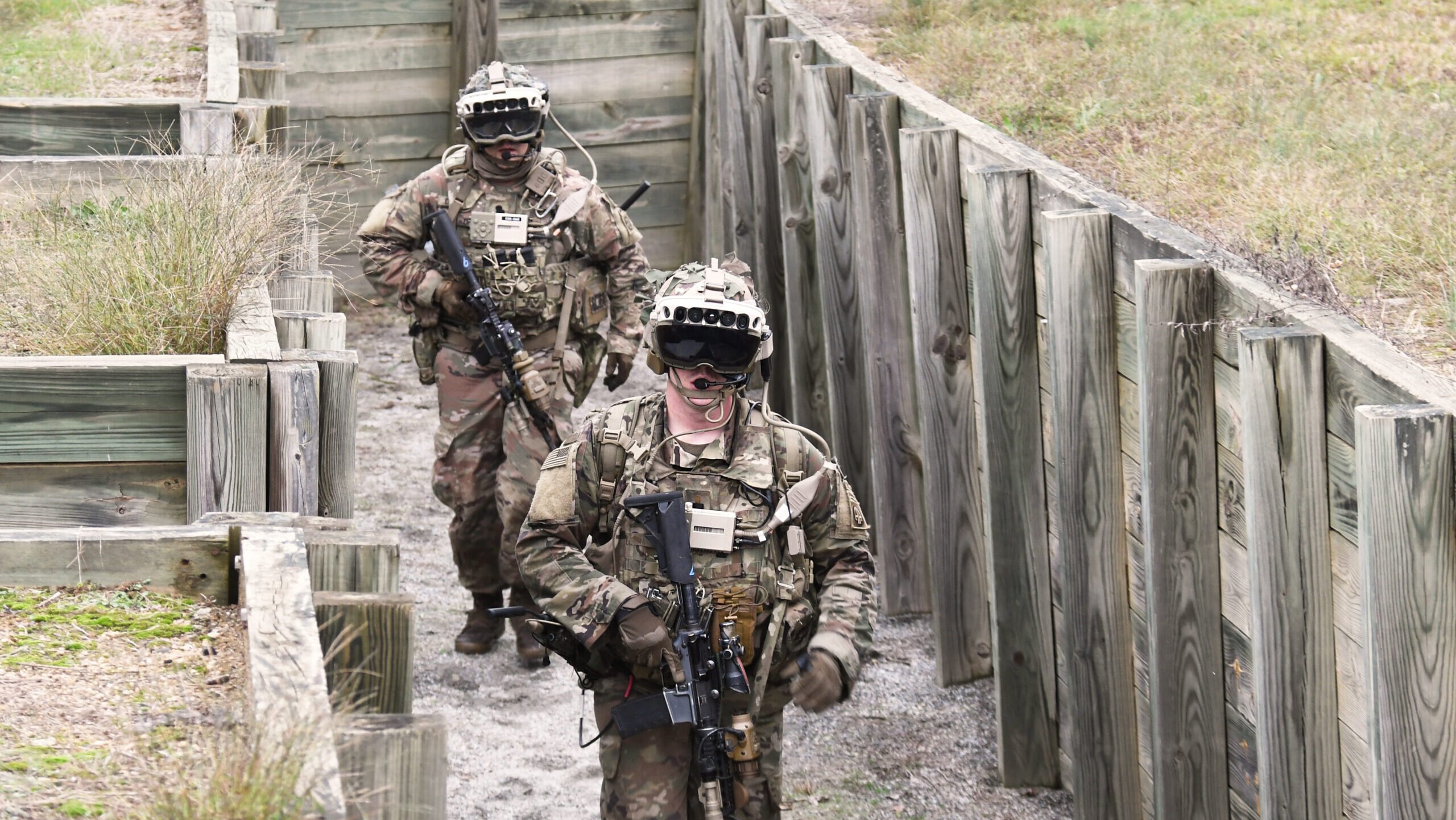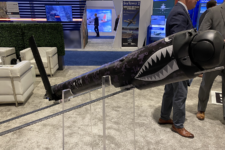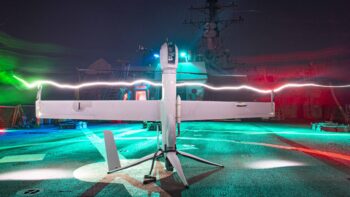
Soldiers from the 82nd Airborne Division used the latest prototype of the Integrated Visual Augmentation System (IVAS) during a trench clearing exercise in October at Fort Pickett, Va. The event was part of a larger Soldier Touch Point, the third major milestone in the development and testing of the IVAS, which will undergo one more STP in the spring before initial fielding next year. (U.S. Army Photo by Bridgett Siter)
WASHINGTON — Soldiers at Fort Moore, Ga., will be the first to receive a small batch of the Army’s initial, 1.0-version of the Integrated Visual Augmentation System (IVAS) when it completes its first fielding later this week, a pair of program officials told Breaking Defense.
Under the delayed and revamped IVAS program, the Army and Microsoft are building a militarized mixed-reality and night-vision device based on the tech giant’s HoloLens 2 head-up (HUD) display. While the duo eye a complete overhaul of the device — dubbed IVAS 1.2 — that would make it suitable for infantry forces in combat, the first 5,000 IVAS 1.0 units to be used for training have been in storage due to a funding shortfall that prevented fielding.
However, there is now funding in place for a “low volume issue of up to 50 systems” to soldiers down in Georgia, IVAS product manager Lt. Col. Denny Dresch, told Breaking Defense on Sept. 22. That fielding should be completed by the end of September, and soldiers will begin training with them.
“They have plans of instruction within their institutional order force generation schoolhouses,” Dresch said. “They have senior [non-commissioned officer] courses that will be utilizing IVAS, as well as … their Airborne Ranger Training Brigade and some are officer training.”
RELATED: Army’s pricey IVAS goggles meet a training obstacle: Doors
As for the remaining 4,950 IVAS 1.0 units still in storage, Dresch said the Army still needs money to get them in the field and is eager to see how the fiscal 2024 defense spending bill shakes out. The officials said they’re hoping for some clarity by the second quarter of FY24, or the January-March 2004 timeframe.
“That will drive the fielding plan,” he added.
However, that decision is in lawmakers’ hands, and the government is bounding towards a shutdown later this week or, at the best, a continuance of FY23 funding levels.
As the Army waits for its budget, though, it is also working with Microsoft on another 5,000 IVAS 1.1 units, designed to improve software stability and add in a new low-light camera.
Microsoft’s plans for its Hololens line and mixed-reality products remain hazy since reports emerged that it may have scrapped Hololens 3 development and laid off staff. Microsoft did not immediately respond to Breaking Defense’s request for comment for this report about IVAS production.
However, Dresch said a production plan for IVAS 1.1 is inked, and Microsoft has a deal with a subcontractor to begin producing those 5,000 units around the January-March 2004 timeframe. If all goes as planned, some of the 1.1 units will start rolling off the production line by mid-calendar year 2024 and delivered to the Army before the end of September 2024.
Marked Improvements
As the Army continues sorting through IVAS 1.0/1.1 fielding and production plans, it’s eyeing a revamped 1.2 version to more holistically address soldier complaints about cybersickness symptoms such as dizziness and nausea, to reliability and comfort.
That new design moves the device from a helmet-like display that’s not easy to remove, with a 70-degree field-of-view, to a hinged, flat design with a 60-degree field-of-view that soldiers can flip up. The computer puck on soldiers’ chests for the earlier versions is moved to the back of the helmet for the 1.2 version, the cord connecting the puck to the HUD is shorted and moved to the back of the HUD, and the new low-light sensor from Canon is included.
In late July, the Army received the first 20 hand-built IVAS 1.2 prototypes, and soldiers from the 10th Mountain Division tested them out in late-August during a phase 1 user assessment at Fort Drum, New York.
So far, so good, Army officials say.
Col. Anthony Gibbs, the project manager for soldier warrior, said the service has gleaned both qualitative and quantitative feedback, and the new low-light camera in the 1.2 shows a “significant improvement” and enabled soldiers to do target recognition “under certain conditions” at various ranges.
Dresch also noted that after soldiers got use to wearing the IVAS 1.2, their reports of discomfort diminished. That feedback promoted the service to move ahead with development.
“Early returns from some initial testing with soldiers at Ft. Drum [were] very positive: That gave me confidence to move to the next step in the rapid prototyping program for this,” Army acquisition head Doug Bush told reporters during a Sept. 19 media roundtable at the Pentagon.
“Going in a step-by-step fashion, we’re gonna develop, test, develop, test, develop, test, before and gather a body of knowledge that gives us confidence in the system before we get into actual production, especially production at scale,” he added.
That next step resulted in Bush greenlighting an additional tranche of $95 million for the production of 280 IVAS 1.2 units and 11 Squad Immersive Virtual Trainer (SiVT) kits centered around IVAS, Gibbs, said during the Sept. 22 interview alongside Dresch.
Gibbs and Dresch noted that the order will include changes to the hinge design based on soldier feedback, and the company is continuing to work on software stability and optimization. Additionally, the service wants to make sure Microsoft has the production facilities in place to produce IVAS at scale, since it handbuilt the first batch of 20 1.2 units.
“They don’t have a line that is pumping out IVASs at a volume of 20,” Dresch said. “But over this next set of 280 deliverables, they will transition to a line which is coming off of a factory.” He did not disclose details about that production plan.
Meanwhile, if production moves smoothly, the service anticipates receiving a limited delivery of those newly ordered units by Dec. 31, and using them for a squad-level assessment in January 2024. Deliveries and testing will continue leading up to an operation demonstration at the company level in 2025 before Army leaders make a production decision.
Airbus US finalizes acquisition of Aerovel as it eyes low-cost drone market
Airbus would also likely respond to a recent request for information on drone capabilities that could replace the Navy’s MQ-8C Fire Scout uncrewed helicopters, said CEO of Airbus U.S. Space and Defense Rob Geckle.


























